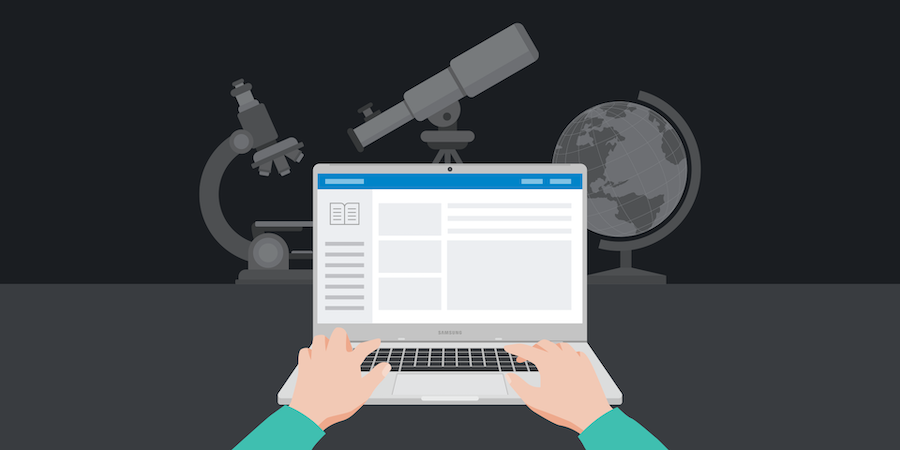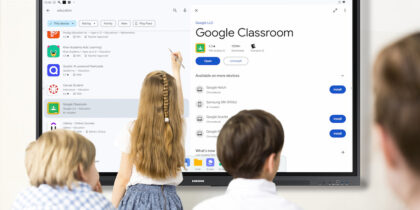As schools shifted to remote learning models in light of the pandemic, students and teachers have been forced to adapt to a new type of education. In many cases, the shift to remote learning revealed gaps in students and teachers’ digital literacy, according to a recent study conducted by education professors at Bridgewater State University. Surveying more than 700 teachers across 40 U.S. states, the study showed that K-12 students have insufficient technology skills, from typing skills to operating basic software to finding and evaluating information.
Digital literacy refers to an individual’s ability to find, evaluate and use digital information. It typically encompasses skills such as typing, software navigation and search engine use. Some education researchers use the term “digital fluency” for a deeper comfort with technology, or the ability to use digital tools in masterful, creative ways. Another related term, digital citizenship, describes a student’s ability to participate in the online world, discern reliable sources of information and manage their digital footprint. Digital citizenship is a particularly important concept for remote learners, as they now manage most of their education and communication online.
While it’s pretty easy for young children to pick up basic digital skills, particularly for consuming content or playing games, the Bridgewater study found that many students need training on how to use digital tools for educational projects.
Digital literacy’s impact on remote learning
As the education process is now entirely digital (with even in-person students working on Chromebooks, laptops and tablets), students need to be adept with digital learning tools in order to perform well on exams, whether they’re standardized grade-level tests or teacher-created assessments for specific courses.
Just as reading is foundational to learning in all other areas, digital literacy is now a prerequisite for educational achievement. Students need to know how to use search engines to conduct research, discern credible sources and think critically about their conclusions. They need to be comfortable with videoconferencing tools like Google Meet and Zoom, as well as a variety of project-building tools and apps, such as Google Docs, Google Sheets and WeVideo. Students also need to grasp the nuances of online communication, using educational platforms like Google Classroom, along with social media.
17 innovative lesson ideas for remote learning
Get your free pack of multidisciplinary lesson plans to teach modern students with modern tools. Download Now
Ultimately, digital literacy skills are essential in most modern workplaces, and will be even more essential when today’s students become adults. Nearly 80 percent of companies are in the process of digitally transforming their operations — which greatly increases the need for workers who are digital natives. To get K-12 students prepared, many schools are emphasizing digital literacy and digital citizenship in their curriculum.
Assessing students’ digital literacy
Teachers can use digital literacy assessments to gauge their students’ proficiency with digital technology and identify where there’s room for improvement. Here are two resources to start with:
- Northstar Digital Learning Assessment: Created by Literacy Minnesota, the Northstar Digital Learning Assessment provides self-guided online assessments that measure basic digital skills in 12 areas, including computer use with different operating systems, basic Microsoft Office, social media and career searching. If students take these assessments in a proctored environment, they can earn badges and certificates for their achievements.
- Learning.com: This digital literacy assessment is based on the skills students will need to succeed in college and in their careers. Based on the 2016 International Society for Technology in Education (ISTE) Standards for Students, the Learning.com assessment gives teachers and students a visual representation of the results. The assessment can be taken on any desktop computer or mobile device.
Supporting teachers’ digital fluency
Building students’ digital literacy starts with giving teachers the support they need to build their own technology skills. As long as remote learning is still the norm, K-12 educators have even more need to become digitally savvy. As teachers continue to evolve their lesson plans, here are some things you can do to support them:
- Provide short, targeted training: Make sure the training you provide teachers isn’t a waste of time. Providing them links to videos that demonstrate how to complete a task within a software platform, for example, may be more helpful than holding an hourlong meeting.
- Make sure teachers always have IT assistance: Ensure that teachers have live tech support available, whether it comes from instructional technology personnel in the district or through the school’s ed tech vendors. For example, you might host regularly scheduled virtual Q&A sessions between IT support staff and teachers.
- Match mentors with mentees: Identify teachers who are fluent with the technology and connect them with teachers who are less comfortable. For example, you might set aside regularly scheduled videoconferences for them to connect on in-service days.
Fostering students’ digital skills
The ISTE has developed a set of standards designed to prepare students to thrive in a technology-driven learning environment. With guidelines for digital citizenship, problem-solving and innovative thinking, the ISTE’s standards include provide school admins with blueprints for their own digital literacy/digital citizenship assessments and coursework.
When we want children to be more comfortable with reading, we surround them with books. By the same token, the best way to help students build confidence in their digital skills is to provide them a wide variety of digital tools. Teachers should encourage their students to experiment, while laying ground rules for staying safe online, limiting digital distractions and avoiding plagiarism. Ultimately, digital literacy starts with teaching students how to be comfortable with digital technology, and how to be responsible for their online presence.
Remote learning is sticking around for the foreseeable future. Teachers should ask students to share how they used particular digital tools to create projects remotely. Students who share their experiences will likely gain confidence, while other students will learn new skills — and everyone will be better prepared for the digitally collaborative workplace.
If you’re not sure which mobile device is right for your students, here’s a comparison of Samsung’s educational Chromebook models, and a rundown of Samsung’s best tablets for remote learning. Having trouble deciding how to choose between Chromebook and tablet? Here’s a quick comparison for remote learners.









